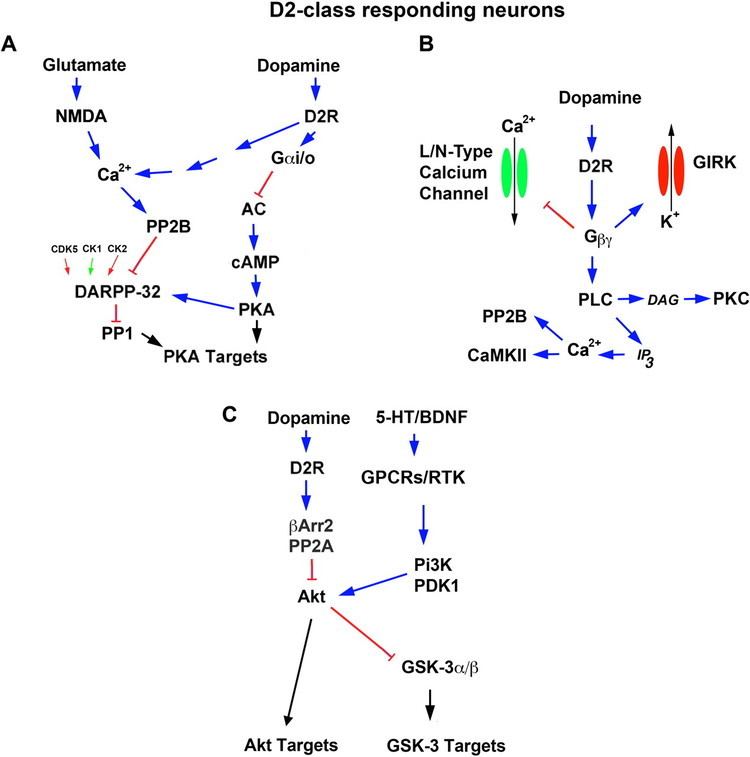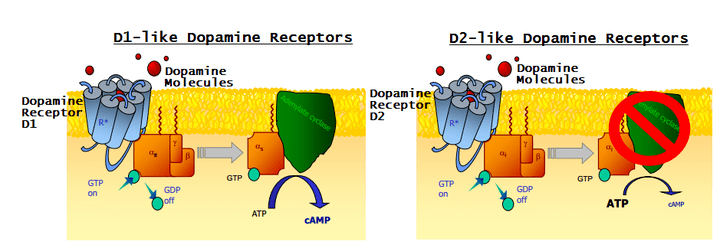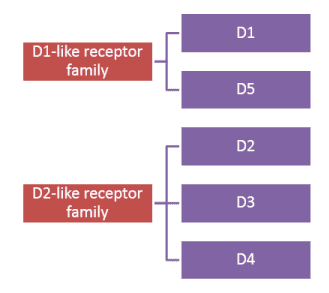Ap1 brain dopamine receptors
Dopamine receptors are a class of G protein-coupled receptors that are prominent in the vertebrate central nervous system (CNS). The neurotransmitter dopamine is the primary endogenous ligand for dopamine receptors.
Contents
- Ap1 brain dopamine receptors
- Adrenergic dopamine receptor physiology medzcool
- Dopamine receptor subtypes
- D1 like family
- D2 like family
- Receptor heteromers
- Signalling Mechanism
- cAMP independent
- Role of dopamine receptors in the central nervous system
- Cardio pulmonary system
- Renal system
- Dopamine receptors in disease
- Attention deficit hyperactivity disorder
- Addictive drugs
- Schizophrenia
- Genetic hypertension
- Dopamine regulation
- References

Dopamine receptors are implicated in many neurological processes, including motivation, pleasure, cognition, memory, learning, and fine motor control, as well as modulation of neuroendocrine signaling. Abnormal dopamine receptor signaling and dopaminergic nerve function is implicated in several neuropsychiatric disorders. Thus, dopamine receptors are common neurologic drug targets; antipsychotics are often dopamine receptor antagonists while psychostimulants are typically indirect agonists of dopamine receptors.

Adrenergic dopamine receptor physiology medzcool
Dopamine receptor subtypes

The existence of multiple types of receptors for dopamine was first proposed in 1976. There are at least five subtypes of dopamine receptors, D1, D2, D3, D4, and D5. The D1 and D5 receptors are members of the D1-like family of dopamine receptors, whereas the D2, D3 and D4 receptors are members of the D2-like family. There is also some evidence that suggests the existence of possible D6 and D7 dopamine receptors, but such receptors have not been conclusively identified.
At a global level, D1 receptors have widespread expression throughout the brain. Furthermore, D1-2 receptor subtypes are found at 10-100 times the levels of the D3-5 subtypes.
D1-like family
The D1-like family receptors are coupled to the G protein Gsα. D1 is also coupled to Golf.
Gsα subsequently activates adenylyl cyclase, increasing the intracellular concentration of the second messenger cyclic adenosine monophosphate (cAMP).

D2-like family

The D2-like family receptors are coupled to the G protein Giα, which directly inhibits the formation of cAMP by inhibiting the enzyme adenylyl cyclase.
Receptor heteromers
Dopamine receptors have been shown to heterodimerize with a number of other G protein-coupled receptors. The resulting dopamine receptor heterodimers include:
Signalling Mechanism
Dopamine receptor D1 and Dopamine receptor D5 are Gs coupled receptors that stimulate adenylyl cyclase to produce cAMP, increasing intracellular calcium among other cAMP mediated processes.. The D2 class of receptors produce the opposite effect, as they are Gαi coupled receptors, and block the activity of adenylyl cyclase. cAMP mediated protein kinase a activity also results in the phosphorylation of DARPP-32, an inhibitor of protein phosphatase 1. Sustained D1 receptor activity is kept in check by Cyclin-dependent kinase 5. Dopamine receptor activation of Ca2+/calmodulin-dependent protein kinase II can be cAMP dependent or independent.
cAMP independent
D1 receptor agonism and D2 receptor blockade also increases mRNA translation by phosphorylating Ribosomal protein s6, resulting in activation of mTOR. The behavioral implications are unknown. Dopamine receptors may also regulate ion channels and BDNF independent of cAMP, possibly through direct interactions. There is evidence that D1 receptor agonism regulates Phospholipase C independent of cAMP, however implications and mechanisms remain poorly understood. D2 receptor signaling may mediate Protein kinase B, Arrestin beta 2, and GSK-3 activity, and inhibition of these proteins results in stunting of the hyperlocomotion in amphetamine treated rats. Dopamine receptors can also transactivate Receptor tyrosine kinases.
Role of dopamine receptors in the central nervous system
Dopamine receptors control neural signaling that modulates many important behaviors, such as spatial working memory. Dopamine also plays an important role in the reward system, incentive salience, cognition, prolactin release, emesis and motor function.
Cardio-pulmonary system
In humans, the pulmonary artery expresses D1, D2, D4, and D5 and receptor subtypes, which may account for vasodilatory effects of dopamine in the blood. In rats, D1-like receptors are present on the smooth muscle of the blood vessels in most major organs.
D4 receptors have been identified in the atria of rat and human hearts. Dopamine increases myocardial contractility and cardiac output, without changing heart rate, by signaling through dopamine receptors.
Renal system
Dopamine receptors are present along the nephron in the kidney, with proximal tubule epithelial cells showing the highest density. In rats, D1-like receptors are present on the juxtaglomerular apparatus and on renal tubules, while D2-like receptors are present on the glomeruli, zona glomerulosa cells of the adrenal cortex, renal tubules, and postganglionic sympathetic nerve terminals. Dopamine signaling affects diuresis and natriuresis.
Dopamine receptors in disease
Dysfunction of dopaminergic neurotransmission in the CNS has been implicated in a variety of neuropsychiatric disorders, including social phobia, Tourette's syndrome, Parkinson's disease, schizophrenia, neuroleptic malignant syndrome, attention-deficit hyperactivity disorder (ADHD), and drug and alcohol dependence.
Attention-deficit hyperactivity disorder
Dopamine receptors have been recognized as important components in the etiology of ADHD for many years. Drugs used to treat ADHD, including methylphenidate and amphetamine, have significant effects on neuronal dopamine signaling. Studies of gene association have implicated several genes within dopamine signaling pathways; in particular, the D4.7 variant of D4 has been consistently shown to be more frequent in ADHD patients. ADHD patients with the 4.7 allele also tend to have better cognitive performance and long-term outcomes compared to ADHD patients without the 4.7 allele, suggesting that the allele is associated with a more benign form of ADHD.
The D4.7 allele has suppressed gene expression compared to other variants.
Addictive drugs
Dopamine is the primary neurotransmitter involved in the reward pathway in the brain. Thus, drugs that increase dopamine signaling may produce euphoric effects. Many recreational drugs, such as cocaine and substituted amphetamines, inhibit the dopamine transporter (DAT), the protein responsible for removing dopamine from the neural synapse. When DAT activity is blocked, the synapse floods with dopamine and increases dopaminergic signaling. When this occurs, particularly in the nucleus accumbens, increased D1 and decreased D2 receptor signaling mediates the "rewarding" stimulus of drug intake.
Schizophrenia
While there is evidence that the dopamine system is involved in schizophrenia, the theory that hyperactive dopaminergic signal transduction induces the disease is controversial. Psychostimulants, such as amphetamine and cocaine, indirectly increase dopamine signaling; large doses and prolonged use can induce symptoms that resemble schizophrenia. Additionally, many antipsychotic drugs target dopamine receptors, especially D2 receptors.
Genetic hypertension
Dopamine receptor mutations can cause genetic hypertension in humans. This can occur in animal models and humans with defective dopamine receptor activity, particularly D1.
Dopamine regulation
Dopamine receptors are typically stable, however sharp (and sometimes prolonged) increases or decreases in dopamine levels can downregulate (reduce the numbers of) or upregulate (increase the numbers of) dopamine receptors.
Haloperidol, and some other antipsychotics, have been shown to increase the binding capacity of the D2 receptor when used over long periods of time (i.e. increasing the number of such receptors). Haloperidol increased the number of binding sites by 98% above baseline in the worst cases, and yielded significant dyskinesia side effects.
Addictive stimuli have variable effects on dopamine receptors, depending on the particular stimulus. According to one study, cocaine, heroin, amphetamine, alcohol, and nicotine cause decreases in D2 receptor quantity. A similar association has been linked to food addiction, with a low availability of dopamine receptors present in people with greater food intake. A recent news article summarized a U.S. DOE Brookhaven National Laboratory study showing that increasing dopamine receptors with genetic therapy temporarily decreased cocaine consumption by up to 75%. The treatment was effective for 6 days. Cocaine upregulates D3 receptors in the nucleus accumbens, possibly contributing to drug seeking behavior.
Certain stimulants will enhance cognition in the general population (e.g., direct or indirect mesocortical DRD1 agonists as a class), but only when used at low (therapeutic) concentrations. Relatively high doses of dopaminergic stimulants will result in cognitive deficits.
